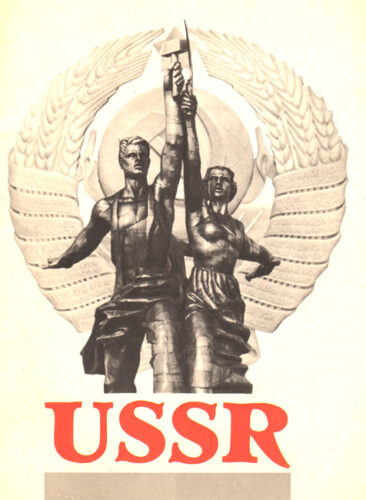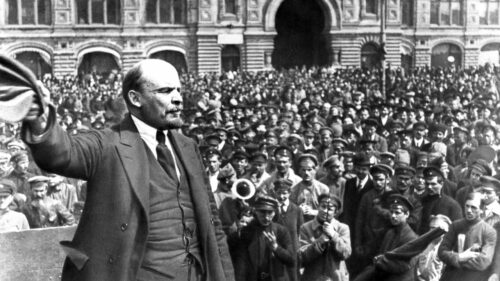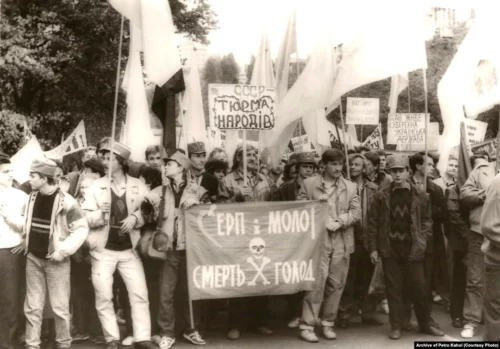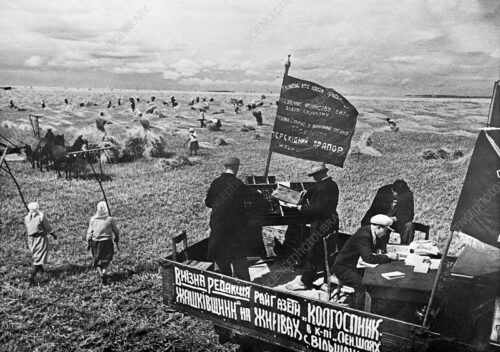

As the world approaches the three-month mark of the Russia-Ukraine war, news of the conflict continues to permeate throughout global headlines. Considering this, it’s worth reviewing the historical context of today’s Russian Federation and specifically, how it formed as a result of the collapse of the Soviet Union in 1991. Predominantly, this article will focus on the social, political and economic consequences this had on today’s Russia.
Soviet Russia: The Rise and Fall of an Isolated Empire.
Since the beginning of Russia’s invasion, The United States and its allies have declared a new strategy of ‘long-term isolation’ in response to Russia’s invasion of Ukraine. However, being treated as a pariah state by Western countries, contained and isolated, is not a new experience for Russia. Indeed, for most of the 20th century, Russia’s emergence as a revolutionary state posed a threat to other global powers. Shortly after the 1917 Russian Revolution, the new government established the Union of Soviet Socialist Republics (USSR) otherwise known as the Soviet Union. Soviet Russia’s isolation from the West manifested in their exclusion from many important forums and treaties such as but not limited to: the Treaty of Versailles, the League of Nations and a variety of trade agreements. In this way it’s evident that the current strategy of isolation is not so much new as it is a continued variant of Soviet era Western foreign policy.
It is worth mentioning that exceptions to the overall hostility between the USSR and the West did exist. The most striking example might be the infamous World War II alliance known as “The Big Three”. The allied powers in this case consisted of the Soviet Union, the United States and the United Kingdom. Although this so-called grand alliance was powerful enough to put an end to the war, it was fraught with internal hostilities that amounted to its downfall after the war.
The end of this grand alliance also marked the beginning of the United States’s official containment post-war foreign policy aimed at countering Soviet and Communist expansionism. The policy could best be seen in the implementation of the 1947 Truman Doctrine and the 1957 Eisenhower Doctrine which both promised economic and military aid to countries that resisted communist insurrection. In retaliation, the Soviet’s created their own organisations such as ‘Cominform’ in 1947 and ‘COMECON’ in 1949 to oppose Western moves. This ultimately led to what former British Prime Minister Winston Churchill famously called an “Iron Curtain” descending in Europe to separate the Soviet Bloc from the West.

Source: Marxists Internet Archive.
What arose from this was a series of events that demonstrated the militarisation of the West’s containment policy. Specifically, in 1949, to contain the Soviet Union through military force, the North Atlantic Treaty Organisation (NATO) was formed. The United States State Department was explicit in prioritising military means over diplomacy when dealing with the USSR as stated in a secret report referred to as “NSC-68”. The most noteworthy point was the report’s call for a build-up of United States military arsenals. These marked the days of the Nuclear Weapons Era and the Cold War’s central threat of mutually assured destruction (M.A.D).
Although the U.S. NSC-68 policy officially ended in 1991 following the collapse of the Soviet Union, a closer inspection suggests the policy never truly ended. Again, in 2022, the West seeks to render Russia an international pariah state through containment and isolation. In the following sections, the political, social and economic consequences of the Soviet Union’s dissolution will be explored further.
The Social Effects of the Fall of the Soviet Union:
The social influence that the collapse of the Soviet Union had on post-Soviet states was reflected in the observable changes in life expectancy and crime rates. The rapid transition from a command economy to a market economy led to societal issues including high unemployment rates, poverty, and income inequality, contributing to a large disparity in life satisfaction between transition and non-transition country residents. In the early 1990s, the mortality rates in Russia more than doubled among working age men, and increased by eighty percent among working age women, with the largest increase in causes of deaths being cardiovascular disease and external causes, including suicides and homocides. These causes of deaths were linked to alcoholism and smoking, both of which correlated with high levels of psychological stress due to economic uncertainty. The liberalisation of the market also meant that alcohol and tobacco became more affordable to the public, making it easier for people to develop unhealthy consumption habits. However, the extent to which the economic transformation impacted public health varied across post-Soviet states, which was contingent on the pace of privatisation and the levels of social capital available to the working age population. Despite adopting the shock therapy model in economic liberalisation, an increase in life expectancy was observed in Poland. This is the result of its stronger social organisations, the option to emigrate to other countries being available to citizens, and its ability to seek support from western countries. On the other hand, the Czech Republic chose a slower, enterprise-by-enterprise privatisation process and minimised the disturbance that the transition has on its economy. In addition, as more than forty-eight percent of adults participated in social organisations such as trade unions, churches, and political organisations, the high levels of pre-existing social capital among the working age population effectively aided in mitigating the negative impact of the economic transition on the country’s public health.

Source: history.com.
The fall of the government also meant that criminal organisations that were unable to survive in the Soviet Union had the opportunity to expand their power and grow their influence over Russian society. As government officials faced underpayment and risks of unemployment following the collapse of the Soviet Union, some former KGB (state security) officers, soldiers and police officers joined the mafia to seek steady employment, while others engaged in corruption in order to supplement the low salaries received. Government officials’ involvement in crimes were prevalent and police officers were called “werewolves in epaulettes”, being associated with blackmailing, firearms trafficking and fabrication of evidence. Furthermore, despite the rapid changes made during the transition away from communism, laws applicable to new economic and political structures had not yet been established, leading to a state of lawlessness in the country. The dysfunctionality of the police service and law enforcement system fostered a lack of trust for police officers among the public, creating the need for people to take alternative measures to protect themselves from becoming victims of crimes. Coping methods include acquiring weapons for self defence purposes, which in some cases had been used for offensive purposes instead and led to negative effects on crime rates. Some chose to purchase protection from private security firms, the police, or criminal groups, which not only encouraged the culture of bribery among government officials, but also exacerbated the existing economic inequality in the Russian society, as those with the ability to afford paid protection could better guard their persons and properties. These self defence methods aiming to compensate for dysfunctional policing instead worsened public safety issues, as the state of lawlessness was reinforced, and the abuse of power by government officials and criminal groups was perpetuated.
Political Effects of the Fall of the Soviet Union:
The collapse of the Union of the Socialist Soviet Republics (USSR) in 1991 has had long-lasting impacts worldwide, but specifically for countries in the former Soviet Bloc. Many of these countries have expressed their approval of the move from the one-party rule and state-controlled economy, a system of which the former Soviet Union was renowned for, to a democratic multiparty system and market economy.
To understand the overarching political effects of the dissolution of the Soviet Union, the fundamental missions of the USSR must be outlined. The Soviet Union was formed after the October Revolution in 1917, which birthed the revolutionary Bolshevik Party led by Vladimir Lenin, that supported Marxist theory. During the late 19th century and early 20th century, Czar Nicholas II led the Russian Empire under a Czarist imperial government known to be highly inefficient plagued with widespread corruption. The Soviet Union was ultimately created in 1922, led by Lenin after Bolshevik revolutionaries ended the Romanov Dynasty by overthrowing Czar Nicholas II.

Vladimir Lenin.
Source: Scalar.
One of the main issues the Soviet Union faced repeatedly was the disunity within the Republic. The USSR consisted of numerous different ethnic minorities who had their own languages, cultures, and land. To address this issue, the USSR attempted to classify every citizen within the Soviet Union, particularly those with non-Russian backgrounds under a ‘promotion of proletariat class mentality’, meaning that those seen to be within the lower-class otherwise known as peasants were to be promoted in mentality to the middle-class where they could enjoy a better standard of life. This mentality instilled in the people, became the one, and likely only, unifying feature across the Soviet Union. This demonstrably caused an issue, as the abundance of cultural history and tradition with the USSR yielded different perspectives, thought patterns and ideologies. It was this, in the end, that ultimately led to the downfall of the Soviet Union.
When then President Mikhail Gorbachev addressed the end of the Cold War between the United States and the Soviet Union in 1991, he noted the fact that a “new world” was emerging, and that the closed, repressive, unequal, and violent nature of the Soviet Union could not go on as it once had. His two major policies, ‘perestroika’, and ‘glasnost’ were the catalyst in the collapse of the USSR. Whilst perestroika focused on more economic-focused reforms, aiming to increase economic growth as well as capital investment, glasnost was the outcome of the failing political system. Glasnost aimed to improve the political landscape by democratising it and effectively ridding the political and bureaucratic apparatus which were rudimentary in ensuring the ideologies of Lenin were maintained. Glasnost also presented an opportunity for more freedom of expression and speech, which catapulted the media into writing about ravaged and stagnant conditions, complaining of the government’s inability to afford the people a better future, creating an opposing point of view to the Soviet Union dogma. This in turn made it harder for the government to exercise control on the reporting of its practices, corruption, and misconduct; it allowed the citizens of the USSR to taste the freedom of expression and speech granted in democracies in the West.

Source: Radio Free Europe.
Furthermore, Gorbachev was losing power within his own government. His policies were not put into practice as he would have liked. Yegor Ligachev, who commanded power with the Central Committee Secretariat became one of the main opponents against Gorbachev, creating arduous processes to get Gorbachev’s ‘modernising’ policies through. It is important to note that Gorbachev was one of few within the government who publicly wanted to ‘change’ the old guard. Whilst Gorbachev understood that the processes and systems in place were not in the best interests for the population, many did not share the same views, instead believing that the ideologies presented by Lenin inspired by Marxist theory were superior. Whilst on paper, the theories of Marx and Engel may be perceived as attractive and rational, Marxist theory is impractical and idealistic at best. The demographic with the Soviet Union was so vast and included approximately 128 different ethnic groups, with at least 130 languages spoken. This resulted in a difficulty in uniting people together to create a Marxist utopia, and ultimately is what led to the downfall of the Soviet Union. At present, there are fifteen countries that make up the former Soviet Union, including: Russia, Estonia, Latvia, Lithuania, Belarus, Ukraine, Moldova, Georgia, Armenia, Azerbaijan, Kazakhstan, Uzbekistan, Turkmenistan, Kyrgyzstan, and Tajikistan, many of which enjoy democratic processes and freedoms. The collapse of the USSR has resulted in many issues within the former Eastern Bloc, with Russia trying to claim sovereign and independent states such as Ukraine and Georgia, resulting in great harm to democratic processes within the region.
Economic Effects of the Fall of the Soviet Union:
The Soviet economy once ranked second in GDP at its economic peak, only behind the other super-power of the twentieth century, the United States of America. During its seventy year existence, the economy of the Soviet Union evolved to adapt to the increasing demands and effects of global events that took place during the twentieth century; it changed from a state-run, command-driven economy to the eventual market-focused economy much like the rest of the western world.
Following the Russian Revolution (1917-23), the former Russian Empire, now the Soviet Union, adopted the Communist style of economy, i.e. a command-driven economy, amongst other things. Communism, or Marxism-Leninsim in particular, is an ideology that essentially is the opposite of Capitalism: the means of production are purely owned by the population instead of by an economic minority. Vladimir Lenin, a Russian politician, is credited with introducing this ideology and implementing it post revolution in Russia. After Lenin’s passing in 1924 Joseph Stalin became dictator of the Soviet Union.
A key component of this style of Communism is state/central planning. Unlike Capitalism, where the market determines what is produced and sold, the state is in charge of what is produced and consumed. Hence, the Soviet Union implemented economic plans and policies to direct the flow of the economy. Whilst the concept is certainly not unique to Communism, these plans and policies were different owing to the nature of the government itself: an authoritarian, collectivist government and society that was controlled by the Politburo, the lone ruling party of the Union, had full control over what was to be produced.
These plans were known as the ‘five-year plans’, and there were twelve in total. The earlier plans focused upon the infrastructure and technology in the Soviet Union, in an attempt to catch-up with the then more technologically advanced Western Europe and America. The first plan in particular introduced concepts such as kolkhoz, collective farming, that became a part of Soviet culture. Kolkhoz were unique in the fact that they were owned by farmers, meaning they had some autonomy and were allowed to sell excess goods after handing in the rest to the government. Whilst some of these collectives succeeded, many failed and eventually famine spread across the Soviet Union during 1932-33.

Source: Science Photo Library.
A particular famine that affected Soviet Ukraine, modern day Ukraine, was called ‘Holodomor’, or the ‘Great Famine’. This particular famine caused approximately four million people to perish, most of whom were ethnic Ukrainians who rejected the kolkhoz method. It is still a question whether or not this famine was a genocide caused by Stalin, but many Western scholars tend to agree that it was a true genocide of Ukrainians. This famine was just one example of Stalin’s hardcore ruling style: by any means neccesary to achieve his dream of a highly developed Communist state.
Despite the social and political issues during this time, the plans for the most part were an economic success: the Soviet Union had joined America as one of the two great superpowers in the world by the 1960s. There were many hiccups on the way, however, as World War II had greatly impacted the agricultural economy and the number of labourers. The once strictly command economy was slowly approaching the market-oriented economy that much of the world had adopted. For example, concepts like profits and currency were introduced, slowly departing from the fully centralised style of economy. Towards the end of the 20th century, where tensions between the United States and Soviet Union lessened, the Perestroika economic movement gained momentum; opening the Soviet Union’s economic doors towards the rest of the world. Gorbachev, pushed reformation on the economy that the economic structure, in time, began to mirror one of a Western developed nation.
The fall of the Soviet Union remains one of the key historical events of the 20th century. The consequences continue to take effect on the countries it consisted of to this day. As the world approaches the ninety day mark of the Ukrainian-Russian war, with no end in sight, tensions are higher than ever. Shocking stories continue to pour out of the war zone. For some, it may be helpful to look to history to help empower us to make sense of this conflict. A historical perspective on contemporary Russia can enable an understanding of the events that are currently unfolding whilst also being able to evaluate competing narratives.
The CAINZ Digest is published by CAINZ, a student society affiliated with the Faculty of Business at the University of Melbourne. Opinions published are not necessarily those of the publishers, printers or editors. CAINZ and the University of Melbourne do not accept any responsibility for the accuracy of information contained in the publication.